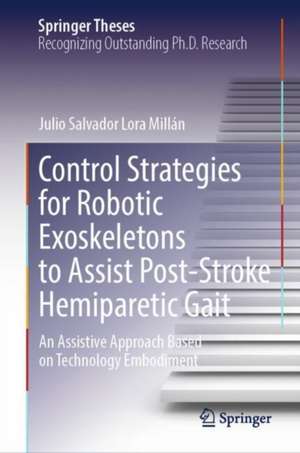Control Strategies for Robotic Exoskeletons to Assist Post-Stroke Hemiparetic Gait : An Assistive Approach Based on Technology Embodiment: Springer Theses
Autor Julio Salvador Lora Millánen Limba Engleză Hardback – 6 iun 2024
Din seria Springer Theses
- 18%
 Preț: 997.88 lei
Preț: 997.88 lei -
 Preț: 389.88 lei
Preț: 389.88 lei - 15%
 Preț: 646.94 lei
Preț: 646.94 lei - 18%
 Preț: 943.43 lei
Preț: 943.43 lei -
 Preț: 399.29 lei
Preț: 399.29 lei - 18%
 Preț: 944.99 lei
Preț: 944.99 lei - 15%
 Preț: 636.80 lei
Preț: 636.80 lei - 18%
 Preț: 941.05 lei
Preț: 941.05 lei - 15%
 Preț: 643.16 lei
Preț: 643.16 lei - 15%
 Preț: 642.68 lei
Preț: 642.68 lei - 18%
 Preț: 1103.62 lei
Preț: 1103.62 lei - 20%
 Preț: 558.83 lei
Preț: 558.83 lei - 18%
 Preț: 1112.30 lei
Preț: 1112.30 lei - 18%
 Preț: 944.19 lei
Preț: 944.19 lei - 18%
 Preț: 1109.92 lei
Preț: 1109.92 lei - 18%
 Preț: 1217.27 lei
Preț: 1217.27 lei - 15%
 Preț: 640.06 lei
Preț: 640.06 lei - 15%
 Preț: 636.45 lei
Preț: 636.45 lei - 15%
 Preț: 640.06 lei
Preț: 640.06 lei - 15%
 Preț: 640.88 lei
Preț: 640.88 lei -
 Preț: 389.70 lei
Preț: 389.70 lei - 20%
 Preț: 563.91 lei
Preț: 563.91 lei -
 Preț: 393.35 lei
Preț: 393.35 lei - 15%
 Preț: 637.93 lei
Preț: 637.93 lei - 15%
 Preț: 641.85 lei
Preț: 641.85 lei - 18%
 Preț: 1225.94 lei
Preț: 1225.94 lei - 20%
 Preț: 551.36 lei
Preț: 551.36 lei - 18%
 Preț: 1229.10 lei
Preț: 1229.10 lei - 15%
 Preț: 639.25 lei
Preț: 639.25 lei - 18%
 Preț: 999.45 lei
Preț: 999.45 lei - 15%
 Preț: 640.06 lei
Preț: 640.06 lei - 18%
 Preț: 1220.45 lei
Preț: 1220.45 lei - 18%
 Preț: 1116.26 lei
Preț: 1116.26 lei - 18%
 Preț: 1110.72 lei
Preț: 1110.72 lei - 18%
 Preț: 1000.87 lei
Preț: 1000.87 lei - 18%
 Preț: 891.17 lei
Preț: 891.17 lei - 15%
 Preț: 640.06 lei
Preț: 640.06 lei - 5%
 Preț: 1154.07 lei
Preț: 1154.07 lei - 15%
 Preț: 635.96 lei
Preț: 635.96 lei - 15%
 Preț: 640.88 lei
Preț: 640.88 lei -
 Preț: 387.20 lei
Preț: 387.20 lei - 18%
 Preț: 1109.92 lei
Preț: 1109.92 lei -
 Preț: 385.25 lei
Preț: 385.25 lei -
 Preț: 385.25 lei
Preț: 385.25 lei - 18%
 Preț: 1112.30 lei
Preț: 1112.30 lei - 18%
 Preț: 999.45 lei
Preț: 999.45 lei -
 Preț: 386.99 lei
Preț: 386.99 lei - 15%
 Preț: 637.13 lei
Preț: 637.13 lei - 20%
 Preț: 554.21 lei
Preț: 554.21 lei - 20%
 Preț: 555.59 lei
Preț: 555.59 lei
Preț: 999.45 lei
Preț vechi: 1218.84 lei
-18% Nou
Puncte Express: 1499
Preț estimativ în valută:
191.30€ • 207.87$ • 160.80£
191.30€ • 207.87$ • 160.80£
Carte disponibilă
Livrare economică 31 martie-14 aprilie
Preluare comenzi: 021 569.72.76
Specificații
ISBN-13: 9783031576157
ISBN-10: 3031576152
Pagini: 200
Ilustrații: XXV, 138 p. 70 illus., 68 illus. in color.
Dimensiuni: 155 x 235 mm
Greutate: 0.43 kg
Ediția:2024
Editura: Springer Nature Switzerland
Colecția Springer
Seria Springer Theses
Locul publicării:Cham, Switzerland
ISBN-10: 3031576152
Pagini: 200
Ilustrații: XXV, 138 p. 70 illus., 68 illus. in color.
Dimensiuni: 155 x 235 mm
Greutate: 0.43 kg
Ediția:2024
Editura: Springer Nature Switzerland
Colecția Springer
Seria Springer Theses
Locul publicării:Cham, Switzerland
Cuprins
Introduction to healthy and post-stroke gait and robotic gait assistance.- Control paradigm for unilateral robotic exoskeletons to assist hemiparetic gait.- The REFLEX exoskeleton.- Evaluation of REFLEX assistance embodiment in stroke patients.- Conclusions and future directions.
Textul de pe ultima copertă
This book presents a new framework to improve the integration of exoskeletons in hemiparetic patients. The idea is to reduce potentially damaging compensatory strategies in the non-paretic leg, by ensuring a proper technology embodiment of the robotic exoskeletons in the nervous system. Upon reviewing control strategies for partial robotic exoskeletons applied to human gait, the book introduces robotic exoskeletons control algorithms, which were developed with the intention to promote gait symmetry by assisting the affected limb of hemiparetic patients according to the movement of the non-paretic leg. This new paradigm aimed at promoting the device's embodiment was expected to counteract the compensation mechanisms, which would become unnecessary and thus disappear. The control strategy relies on the gait phase estimation of the sound leg calculated using an adaptive frequency oscillator and was evaluated on post-stroke patients affected by hemiparetic gait, and the results are described in this book. All in all, this book offers a timely snapshot on control strategies for post-stroke robotic gait assistance. It also presents new findings concerning the role of robotic controllers in the embodiment of such devices, and their implications for new assistance paradigms for people with neurological gait disorders.
Caracteristici
Nominated as an outstanding PhD thesis by the Bioengineering Group of Comité Español de Automática Presents a control paradigm for partial robotic exoskeletons based on the movement of the non-assisted leg Discusses technology embodiment and its effect on gait control to assist post-stroke hemiparetic gait
